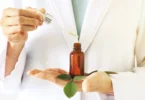About 20 customers a day walk through the doors of Holy Smokes, a vape and smoke shop in Philadelphia, looking to buy kratom, the herbal product derived from the leaves of a Southeast Asian tree.
Users and businesses that sell and manufacture it say kratom (pronounced Kray-tuhm) helps to relieve pain, gives a mild boost like coffee (the tree is part of the coffee family) — and can even help ease the pain of opioid withdrawal.
The U.S. Food and Drug Administration says the product — not regulated as a drug because it is classified as a dietary supplement — is a dangerous, addictive drug that acts on the brain’s opioid receptors, and has been linked to 44 deaths.
“There is no evidence to indicate that kratom is safe or effective for any medical use,” stated FDA Commissioner Scott Gottlieb in February. “And, claiming that kratom is benign because it’s “just a plant” is shortsighted and dangerous.”
The agency issued a recall in November because of possible health risks. Earlier this month the Centers for Disease Control and Prevention linked kratom to a multi-state outbreak of salmonella that has so far sickened 87 people in 35 states and issued a recommendation that people not use it in any form.
Several states including Alabama, Arkansas, Indiana, Tennessee and Wisconsin ban the substance; others have legislation to ban it pending. It is also listed as a controlled substance — like heroin — in 16 countries including Thailand and Malaysia, where it is grown, the FDA reports.
The warnings haven’t stopped the clients at Holy Smokes, located at 203 S. Juniper St., said acting manager Charlie Goodine.
“We sell a lot of kratom,” he said. Some customers use the product to help with opioid withdrawal or as a replacement for prescription opioids such as OxyContin and Percocet.
“It’s pretty much the cure for opioid withdrawal.” Goodine said. It takes about two weeks for the physical symptoms to subside, he said.
Scientific studies have indicated that the most effective treatment for opioid withdrawal does include the medically supervised use of opioid medications such as methadone. But the FDA has stated that there is no reliable evidence that kratom can safely be used this way.
“The FDA stands ready to evaluate evidence that could demonstrate a medicinal purpose for kratom. However, to date, we have received no such submissions and are not aware of any evidence that would meet the agency’s standard for approval,” Gottlieb stated.
Goodine is aware of the FDA’s position on kratom and feels the agency is siding with “big Pharma” and against any product that might interfere with the sale of prescription drugs.
Kratom is sold online, in gas stations, and in smoke shops. It is also known as Thank, Kakua, thom, Ketom and Biak and is typically brewed as a tea, chewed, smoked or ingested in capsules.
Holy Smokes gets kratom directly from Indonesia and not from the Oregon-based PDX Aromatix in Portland that recalled its kratom products due to salmonella, Goodine said.
The bitter taste could be compared to a really strong matcha powder, made of ground-up green tea leaves, Goodine said. Ten one-gram capsules of kratom cost $20, while 30 grams of powder is $34.99. Goodine has used the herb and compared it to “taking an aspirin and drinking coffee.”
Not surprisingly, the American Kratom Association insists “it is not dangerously addictive and it is not dangerous,” said Mac Haddow, the director of government relations for the group. The deaths associated with kratom have with one exception not been caused by the substance but by other drugs that were found in combination with kratom, he said.
“You can’t take enough to hurt yourself,” Haddow said, echoing Goodine’s contention that opponents just want to cut out competition for the pharmaceutical industry.
Haddow produced reports indicating kratom is a safe way to get a mild mood boost and some pain relief. But he admitted some of the research behind it was paid for by the association.
He contended that kratom doesn’t act on the brain’s opioid receptors the way prescription painkillers and heroin do. But back in 2016, the Journal of the American Chemical Society reported that kratom indeed works this way. Last month, an FDA study found that 22 of the 25 of the most prevalent compounds in kratom do bind to opioid receptors, and so should be considered an opioid. The study also said most deaths did occur in people who used kratom in addition to other drugs, though in one case, only kratom was detected.
The Philadelphia Medical Examiner’s Office has not attributed any deaths to kratom, nor any of its active ingredients, said James Garrow, spokesperson for the Department of Public Health.
“However, given that it is the subject of a voluntary U.S. FDA recall, is currently implicated in a nationwide outbreak of salmonella, and there exists no scientific evidence that it is safe or effective for any medical use, it is our recommendation that people not consume any brand of kratom in any form,” he stated in an email.
NMS Labs, a nationally known forensic laboratory in Willow Grove, started testing for mitragynine, the active component in kratom, about five years ago, said Kelly Ciliberto, toxicology administrator.
“We see it fairly frequently in our post mortem case work,” Ciliberto said. Between one and three percent of the cases contain some evidence of the substance but it is found mostly alongside other drugs. The samples come from all states, she said.
The facility performed the toxicology tests in the August accidental death of a New York police officer from Tupper Lake, a community about 110 miles north of Albany, who had been making the powdered kratom into a paste and eating it, Ciliberto said.
The coroner ruled Sgt. Matthew Dana died of a hemorrhagic pulmonary edema, or blood in the lungs, which resulted from an overdose of mitragynine, the Adirondack Daily Enterprise reported.
“If people are saying (kratom) is like coffee, that is misleading and dangerous,” Ciliberto said.







